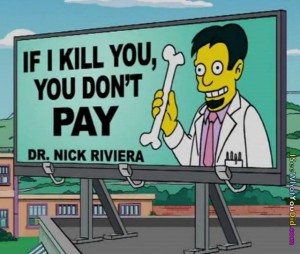Happy Friday, dear readers!
Your humble blogger congratulates you on surviving another week – one riddled with Halloween trick-or-treaters and the final stretch of the Presidential election. (Your humble blogger is, of course, writing in “giant meteor” in an effort to end it all…)
Anywho, I have some news today that’s fairly reassuring: it looks like the Court of Appeals’ decision in Margaris (IMR can be as late as it wants!) is being given due weight.
Recently, the Court of Appeal denied applicant’s petition for a writ of review of the WCAB’s reversal of a WCJ’s ruling that IMR is invalid if late. Got that?
Ok, in case you’ve checked out for the weekend, it goes like this:
WCJ: IMR is late, but I still can’t award medical care!
Applicant: Oh yeah? I’ll show you… To the Recon Department!
WCAB: WCJ is right – even if late, only UR/IMR can award medical care.
Applicant: Oh yeah? I’ll show you… To the Court of Appeal!
CoA: Did I stutter? IMR CAN BE LATE!
Ok, so what happened in the case of Tyni v. City of Montebello? Applicant sustained an admitted injury and his primary treating physician requested treatment that UR found to be unnecessary in a timely UR denial. Applicant sought IMR and, when IMR did not render a decision 30 days of the application for IMR (the WCAB corrected this on reconsideration – it’s 30 days from receipt of the application and supporting documentation; see Labor Code section 4610.6(d)) he sought to invoke the WCAB’s jurisdiction to decide whether he should be entitled to the requested treatment.
At trial, the WCJ ruled that even if it is late, the determination is still confined to IMR, a ruling bolstered by the Court of Appeal in Stevens (somewhat in dicta) and Margaris as mentioned above. Recon only reversed to correct the timeline as above, but otherwise upheld the WCJ: effectively, applicant’s request for treatment can linger for all eternity.
In this case, of course, the determination came some four months (rather than 30 days) after the application, but that is of no importance.
Now, I understand what some of my readers will say, either sincerely or sarcastically: how could this be a good system? How could employers and insurers reap the benefits of administrative delays while injured workers linger without their medical treatment?
Well your humble blogger has been told by some applicant attorneys that regardless how small or how big, now necessary or how wasteful, they will request IMR for every single denied UR to purposefully drive up costs and to clog IMR with a flood of requests.
“Settle with me now,” they say “or you’ll pay as much in IMR costs and compliance.”
Well, the rule of unintended consequences applies here too. Guess what? All those petty IMR requests that were initiated as punitive measures have clogged up the system to the point where even legitimately injured workers can’t have their treatment requests evaluated on time. Even Procrustes had to eventually sleep in the bed he made.
Long story short, dear readers – it looks like there’s no inventive reason the WCAB is accepting for why IMR should be deemed invalid if untimely. So let’s keep UR churning out timely and let IMR do it’s thing.
Have a good weekend!



